
I get simple enjoyment out of growing Tabasco peppers. They remind me of thanksgiving and Christmas all rolled into one. I know it sounds strange but it's the colors. They are like little bulbs standing straight and tall in beautiful shades of orange and red. The happiness they make me feel when I see them in the yard all bright and beautiful against the dying fall garden is just that, pure happiness.

About Tabasco
Tabasco originates in mexico. They have a heat level that ranges from 30,000 to 50,000 on the heat scale. It's heat compares to the Cayenne pepper and has a hotter burn than the jalapeno pepper. I love it however, on eggs and in stews and salsa. Tabasco's are tapered and grow about 2 to 3 inches in length and are most famous for the world renowned Tabasco hot sauce.

Growing Tabasco
-
- Tabasco takes about 80 to 90 days to grow. Therefore one should plan to start them indoors if living in a climate with short summer periods.
- Start seeds in loose soil set about ½ inch down. I like using Grow mate Organics Root Max to give them an exceptional start.
- Tabasco needs warm temperatures from 75 degrees up.
- Plant in a sunny location with well draining soil and feed them monthly with Epsom salt and Coffee Grinds. I also had great results spraying them monthly with Happy Tree Microbes
- Tabasco needs room to branch! Plant to space the plants between 1.5-2 feet apart from each other.
- Harvest Tabasco when the peppers have turned orange or red. Be careful though they turn quick! They can hit that red color and within a day or so start to brown out. As such be ready for harvest! Tabasco can be harvested when green or pale yellow and allowed to ripen indoors if needed. Their flavor however is best when harvested at the last minute!
- Tabasco needs around an inch of water a week, heavier watering during fruiting! I allow them to dry between watering. However, if temps reach above 95 degrees and they are fruiting, lean towards a consistent slightly moist soil to help avoid calcium issues. For example, blossom end rot.

Companion Planting with Tabasco Plants
There is mixed opinion on Tabasco plants in regards to companion planting. I read years ago from Homeguides SFGates to plant them separate from tomatoes, eggplants and potatoes. to avoid soil borne diseases prevalent in these types of plants. Other sites promote them together. Personally I have always kept my peppers separate, grown in another spot away from tomatoes and eggplant and practice planting with the following:
-
- Zinnias, Basil, Garlic Chives, Marigolds, Lavender and Rosemary.
- Planting peppers around these flowers supports both plants. The flowers bring pollinators that help peppers have the best possible fruiting, In return peppers help protect the flowers from insects that don't like the smell of hot spicy peppers.
In The Works
-
- Tabasco Hot Sauce Recipe !















 germinate. I stubbornly refused to get one for years. I do have peppers every year so it’s not a complete loss to go without a mat. However, I struggled with germination on many hot peppers simply because of their strict need for heated soil. Once a mat was obtained results in the number of plants actually germinating improved right away! Vivosun has some very good options for mats. They are also terribly simple to use so highly recommend this gem.
germinate. I stubbornly refused to get one for years. I do have peppers every year so it’s not a complete loss to go without a mat. However, I struggled with germination on many hot peppers simply because of their strict need for heated soil. Once a mat was obtained results in the number of plants actually germinating improved right away! Vivosun has some very good options for mats. They are also terribly simple to use so highly recommend this gem. 



You must be logged in to post a comment.